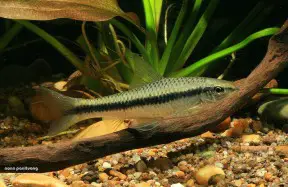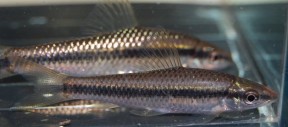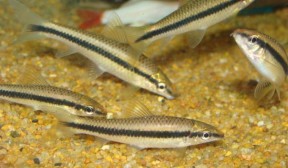Crossocheilus atrilimes
Siamese Algae Eater
Etymology
Crossocheilus: from the Ancient Greek κροσσός (krossós), meaning ‘fringe, tassel’, and χείλος (cheílos), meaning ‘lip’, in reference to the barbels on the upper lip in members of this genus.
atrilimes: from the Latin ater, meaning ‘black’, and limes, meaning ‘a narrow and elongate space’.
Classification
Order: Cypriniformes Family: Cyprinidae
Distribution
The type specimens were collected from the Nam Mang River, Vientiane Province, Laos but the species is thought to occur throughout the Mekong and Chao Phraya drainages, so can also be found in Thailand and Cambodia.
The full type locality is ‘Nam Mang at Keng Nam Mang (rapids), about 6 kilometers upstream of Ban Hatkhai, 18°26’33″N, 103°10’32″E, Vientiane, Laos’.
The distribution of laterally-striped Crossocheilus spp., particularly in Thailand, requires further study as some populations may apparently represent undescribed species.
Habitat
Inhabits flowing streams and tributaries with substrates of boulders, pebbles, gravel and sand, often in areas with submerged driftwood or tree roots. The clear, often shallow, water allows sunlight to penetrate the surface and the development of a rich biofilm covering submerged surfaces upon which the fish browse. It is thought to undergo seasonal migrations during which it can be found in deeper, more turbid water.
Maximum Standard Length
This is one of the smaller members of the genus and is fully-grown at 70 – 75 mm.
Aquarium SizeTop ↑
A small group can be kept in an aquarium with base dimensions of 120 ∗ 30 cm but be sure to identify your fish correctly as other members of the genus can reach 150 mm SL and require much larger quarters.
Maintenance
This species will do well in most well-maintained tanks but is best-suited to a set-up designed to resemble a flowing river or stream, with a substrate of variably-sized rocks, gravel and some large water-worn boulders.
This can be further furnished with roots and branches arranged to form a network of nooks, crannies and shaded spots. While the majority of plant species will fail to thrive in such surroundings hardy types such as Microsorum, Bolbitis or Anubias spp. can be grown attached to the décor and bright lighting will promote the growth of algae upon which the fish will graze. In this kind of environment it will display more natural behaviour and can be kept alongside other species that enjoy similar conditions.
Like many fishes that naturally inhabit running waters it’s intolerant to the accumulation of organic wastes and requires spotless water at all times in order to thrive. It also does best if there is a high level of dissolved oxygen and a decent level of water movement in the tank so a external filters, powerheads or similar should be employed in order to obtain the desired effect.
Water Conditions
Temperature: 20 – 26 °C
pH: 6.0 – 7.5
Hardness: 18 – 268 ppm
Diet
‘Crossocheilus siamensis’ (see ‘Notes’) is famed as a consumer of ‘black brush’ algae (BBA), also known as ‘red’ or ‘beard’ algae. These members of the Division Rhodophyta can be otherwise difficult to remove once established in aquaria so the ‘species’ has achieved huge popularity among hobbyists who maintain planted set-ups.
Presumably this saleability is also one reason why several fishes, including C. atrilimes, are offered under the name. These do browse on BBA but to varying extents depending on species and in some cases the availability of alternative food sources. C. atrilimes, for example, shows a preference for fine-leaved, higher plants such as Vesicularia spp. but will also feed on various types of algae. C. langei sensu amplo is the most efficient consumer of BBA although some reports state that only younger, softer growths are eaten and that the fish should be introduced prior to any potential outbreak.
In nature Crossocheilus species are aufwuchs grazers feeding on algae, diatoms and other phytoplankton, plus associated microorganisms. The use of high-protein foods in the aquarium should therefore be avoided as the fish are unable to metabolise some components efficiently; regular, prolonged consumption can result in excessive deposits of fat and even organ degeneration.
A good quality dried product(s) with added Spirulina or similar is ideal but plenty of fresh vegetable matter should also be included in the diet. Shelled peas, blanched courgette, spinach and chopped fruit all make good additions to the menu. Once settled into the aquarium the fish sometimes ascend into midwater to feed and in a set-up as described above will often be seen browsing the biofilm that tends to form on the rockwork.
Behaviour and CompatibilityTop ↑
Generally peaceful and can be maintained alongside many of the more popular species in the hobby although it is perhaps preferable to select fishes from from one of its native countries or rivers. Possibilities from Thailand alone include Botia rostrata and Crossocheilus reticulatus plus various Cyclocheilichthys, Devario, Mystacoleucus, Rasbora, Garra, Homaloptera, Lepidocephalichthys, Nemacheilus, Syncrossus, Yasuhikotakia and Schistura species.
Crossocheilus spp. are typically found swimming in loose aggregations in nature and can exhibit shy or skittish behaviour if kept singly or in small numbers. They are shoaling, rather than schooling, fishes which develop a distinct pecking order and are best-maintained in a group of six or more since weaker individuals may be bullied incessantly if smaller numbers are kept. You’ll be rewarded with a more natural-looking display plus interesting behaviour from the fish as they interact with one another.
Sexual Dimorphism
Sexually mature females are normally thicker-bodied than males but it’s impossible to accurately sex young fish by external characters.
Reproduction
Not thought to have occured in captivity although the young fish widely available in the trade are assumed to be farmed via the use of hormones. Members of this genus are known to undergo seasonal reproductive migrations in nature, moving upstream during the dryer months and in the opposite direction when water levels rise.
NotesTop ↑
This species is among a handful of near-identical congeners that are traded as ‘Siamese algae-eater’ (often abbreviated to ‘SAE’), ‘Siamese flying fox’ and ‘Crossocheilus siamensis’.
The latter name is not valid, however, and is a synonym of Epalzeorhynchos siamensis which is itself a synonym of Crossocheilus oblongus, a species described from Java. C. oblongus is currently accepted to range throughout Indochina and the Sunda Islands but its identity is unclear although its name is routinely applied to fish in the aquarium trade. It was described as a blueish fish with yellow fins and is almost certainly not the ‘SAE’ in the aquarium hobby.
Separating the species found on sale as ‘C. siamensis’ is tricky but differences do exist if combinations of characters are considered. C. atrilimes can be diagnosed by the following combination of characters: midlateral stripe extending to posterior extremity of median caudal-fin rays; 1 or 2 rows of faint dark spots along scale rows below lateral line; 1-1½ scale rows between anus and anal-fin origin; body depth 23.8-26.4 % SL; a single pair of rostral barbels.
The black lateral stripe runs from the snout to the tip of the caudal fin; the eye is pale brown above the pupil and white below; maxillary barbels are not visible; the lateral line is curved; the fins are a pale dusky yellow colour. Depending on mood this species has the ability to change the appearance of the dark body stripe, most obviously during bouts of sparring when it becomes much broader and paler in colour.
C. langei sensu amplo seems to be another commonly-traded, laterally-striped Crossocheilus and can be told apart from C. atrilimes by the following characters: the eye is reddish-golden above the pupil and white below; it has two pairs of barbels; the lateral line is essentially straight and passes through the centre of the dark body stripe; the fins are brownish.
Although the body stripe becomes paler when the fish are sparring it doesn’t change in width, and a further simple distinguishing trait is the presence of a dark blotch immediately in front of the anal fin on the underside of the fish. This fish is the one most often referred to as ‘Siamese algae eater/SAE’ in aquarium literature, but because it varies slightly from C. langei sensu stricto the possibility that it is not that species cannot be discounted.
The third most common fish in the aquarium hobby is an undescribed species sometimes referred to as C. sp. ‘citripinnis’. It’s a larger fish growing to 150 mm SL and possessing a clearly visible pair of maxillary barbels. The fins are lemon yellow in colour, this becoming more intense as the fish mature; the dark body stripe doesn’t alter in width or colour when the fish are sparring; the lateral line is curved and the overall body shape is similar to C. atrilmes meaning they’re easily confused as juveniles. There may also be other, potentially undescribed, species from Thailand being traded as ‘C. siamensis’ but as yet no detailed study has been conducted.
In 2009 Tan and Kottelata described a new laterally-striped species, C. obscurus, from the Batang Hari river drainage in Sumatra. This species also grows relatively large (to “at least” 5.6″/14.2 cm) and is further distinguished as follows: one pair of rostral barbels, no maxillary barbels; midlateral stripe with edges not sharply contrasted, slightly curved downward, obscured in largest individuals, continued on median caudal-fin rays, reaching posterior margin; no black mark between anus and anal fin; mouth wide (30-36% HL). It’s possible that C. obscurus has also appeared in the aquarium trade under a different name.
Other species of laterally-striped Crossocheilus also exist and may be available from time-to-time but are more easily told apart from the group described above.
In C. nigriloba, for example, the dark body stripe uniquely breaks up into a series of blotches when the fish are sparring, stressed or sleeping and the lower caudal fin lobe contains dark pigmentation suffused with red, while C. burmicanus exhibits a patch of blue colouration at the base of the pectoral fins.
To add further confusion the vaguely-similar Garra cambodgiensis (itself often referred to incorrectly as G. taeniata) is usually sold with the name ‘false SAE’ although this one is easily-identifiable as the dark lateral stripe ends at the caudal peduncle, all barbels are tiny and it has a disc-like lower jaw which sometimes develops bright red colouration on the outer lips.
Epalzeorhynchos kalopterus is sometimes misidentified as a Crossocheilus sp. but exhibits several distinguishing traits, the most obvious of which are the characteristic white-edged, red and black coloured fins. Also comparable are the Paracrossochilus species from the island of Borneo but these are almost unknown in aquaria.
Members of Crossocheilus are characterised by possessing 8 branched dorsal fin rays, immobile rostral lobes, lacking a dorsal spine and by the fact that the upper and lower lips aren’t connected, the upper being attached to the lower jaw via a thin membrane.
References
- Kottelat, M., 2000 - Journal of South Asian Natural History 5(1): 37-82
Diagnoses of a new genus and 64 new species of fishes from Laos (Teleostei: Cyprinidae, Balitoridae, Bagridae, Syngnathidae, Chaudhuriidae and Tetraodontidae). - Kottelat, M., 2003 - Raffles Bulletin of Zoology 51(2): 399-401
Nomenclatural status of Crossocheilus burmanicus, C. horai and C. multirastellatus (Osteichthyes: Cyprinidae). - Kottelat, M., 2001 - WHT Publications, Colombo: 1-198
Fishes of Laos. - Kottelat, M., 2013 - The Raffles Bulletin of Zoology Supplement 27: 1-663
The fishes of the inland waters of southeast Asia: a catalogue and core bibiography of the fishes known to occur in freshwaters, mangroves and estuaries. - Niederle, J., 2009 - The Aquarium Gazette 8
My anabasis with red-algae eaters known as Crossocheilus siamensis. - Rainboth, W. J., 1996 - FAO, Rome: 1-265
Fishes of the Cambodian Mekong. FAO Species Identification Field Guide for Fishery Purposes. - Tan, H. H. and M. Kottelat, 2009 - Ichthyological Exploration of Freshwaters 20(1): 13-69
The fishes of the Batang Hari drainage, Sumatra, with description of six new species.







February 22nd, 2016 at 9:03 pm
I’m wondering if most of the pics possibly excluding pic5 are of C. oblongus ?
February 23rd, 2016 at 1:30 pm
Hey Andy, presume you’re spot on as usual. Have I missed some publications or a discussion somewhere?
February 27th, 2016 at 9:32 pm
Hi Matt , sorry I think I may have jumped the gun a bit , still trying to figure out the visual differences for these = Atrilimes , Citripinnis , Langei and Oblongus :).
March 1st, 2016 at 1:40 pm
Hi Andy, no worries and saw you started some discussion elsewhere. Will try and chip in when I find time to sit down – absolutely barmy at the moment.